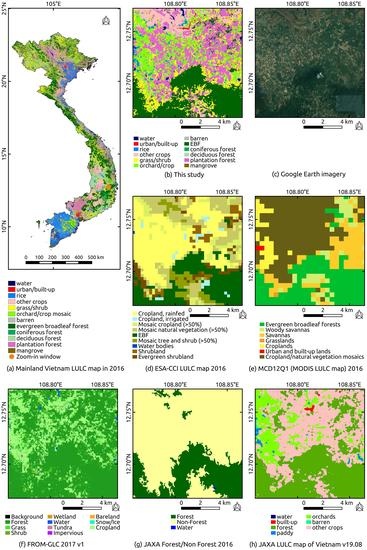New JAXA High-Resolution Land Use/Land Cover Map for Vietnam Aiming for Natural Forest and Plantation Forest Monitoring
Abstract
1. Introduction
2. Materials and Methods
2.1. Study Area
2.2. Mapping Approach
- (1)
- Vertical structure: plantation forests demonstrate uniform structures such as the lattice pattern of rubber in Figure 1e or the dense pattern of acacia in Figure 1f. Trees of plantation forests have the same height, same diameter at breast height (DBH), and same density. On the contrary, natural forests present nonuniform structures such as a random pattern of canopies as seen in Figure 1b. Natural forests are structurally very diverse with a high degree of variation in height classes, DBH and densities. This difference can be recognized by the combinations of L-band SAR polarizations of horizontal transmit–horizontal receive (HH) and horizontal transmit–vertical receive (HV);
- (2)
- Biophysical features and water content: the chlorophyll concentration, greenness, brightness, moisture, etc. of plantation forest canopies are different from those of natural forest canopies. This difference can be recognized using water and vegetation indices derived from optical images;
- (3)
- Topography: plantation forests are mostly cultivated in low slope lands while natural forests grow in higher slope lands. This difference can be recognized by topography data.
- Integrating information from various sensors to recognize all the differences between the two forest types;
- Making use of the time-series data to capture information on the phenology, which are essential for the classification of deciduous forests, rice, and other agricultural crops;
- Making use of the spectral indices and radar indices aside from the original bands and polarizations. As the indices are less sensitive to atmospheric noise and viewing geometry, they can support the geographical transferability.
2.3. Satellite Data and Preprocessing
2.3.1. PALSAR-2/ScanSAR Time-Series Data and Single-Temporal PALSAR-2 Mosaic
2.3.2. Sentinel-1 Time-Series Data
2.3.3. Sentinel-2 and Landsat-8 Data
2.3.4. AW3D30 Topographic Data
2.4. Reference Data and Classification Scheme
3. Results
3.1. Evaluation of the Classification Performance of Satellite Data
3.2. The Resultant Vietnam LULC Map 2016 and Its Comparison to Other LULC Products
3.3. Comparison of Forest Areas between This Study’s Map and Vietnam National Statistical Data
3.4. Comparison between This Study’s Map and the Vietnam Forest Resource (VFR) Map 2016
4. Discussion
4.1. Advantages and Potential Applications of the Resultant LULC Map
4.2. Limitations and Challenges of This Study’s Map
4.3. Future Research Directions
5. Conclusions
Supplementary Materials
Author Contributions
Funding
Acknowledgments
Conflicts of Interest
References
- FAO. Global Forest Resources Assessment 2020 Key Findings; FAO: Rome, Italy, 2020. [Google Scholar]
- Curtis, P.G.; Slay, C.M.; Harris, N.L.; Tyukavina, A.; Hansen, M.C. Classifying drivers of global forest loss. Science 2018, 361, 1108–1111. [Google Scholar] [CrossRef] [PubMed]
- Rivera, A.; Bravo, C.; Buob, G. Climate Change and Land; IPCC: Geneva, Switzerland, 2020; ISBN 9789291691548. [Google Scholar]
- Hornung, M.; Stevens, P.A.; Reynolds, B. The effects of forestry on soils, soil water and surface water chemistry. In Proceedings of the Environmental Aspects of Plantation Forestry in Wales; Good, J.E.G., Ed.; NERC/ITE: Cumbria, UK, 1987; pp. 64–69. [Google Scholar]
- Salati, E.; Nobre, C.A. Possible climatic impacts of tropical deforestation. Clim. Chang. 1991. [Google Scholar] [CrossRef]
- Anselmetti, F.S.; Hodell, D.A.; Ariztequi, D.; Brenner, M.; Rosenmeier, M.F. Quantification of soil erosion rates related to ancient Maya deforestation. Geology 2007. [Google Scholar] [CrossRef]
- Barlow, J.; Lennox, G.D.; Ferreira, J.; Berenguer, E.; Lees, A.C.; Mac Nally, R.; Thomson, J.R.; Ferraz, S.F.D.B.; Louzada, J.; Oliveira, V.H.F.; et al. Anthropogenic disturbance in tropical forests can double biodiversity loss from deforestation. Nature 2016. [Google Scholar] [CrossRef] [PubMed]
- Carnus, J.M.; Parrotta, J.; Brockerhoff, E.; Arbez, M.; Jactel, H.; Kremer, A.; Lamb, D.; O’Hara, K.; Walters, B. Planted forests and biodiversity. J. For. 2006. [Google Scholar] [CrossRef]
- Campbell, A.; Clark, S.; Coad, L.; Miles, L.; Bolt, K.; Roe, D. Protecting the future: Carbon, forests, protected areas and local livelihoods. Biodiversity 2008. [Google Scholar] [CrossRef]
- Senf, C.; Pflugmacher, D.; van der Linden, S.; Hostert, P. Mapping rubber plantations and natural forests in Xishuangbanna (Southwest China) using multi-spectral phenological metrics from modis time series. Remote Sens. 2013, 5, 2795–2812. [Google Scholar] [CrossRef]
- Fan, H.; Fu, X.; Zhang, Z.; Wu, Q. Phenology-based vegetation index differencing for mapping of rubber plantations using landsat OLI data. Remote Sens. 2015, 7, 6041–6058. [Google Scholar] [CrossRef]
- Dong, J.; Xiao, X.; Chen, B.; Torbick, N.; Jin, C.; Zhang, G.; Biradar, C. Mapping deciduous rubber plantations through integration of PALSAR and multi-temporal Landsat imagery. Remote Sens. Environ. 2013. [Google Scholar] [CrossRef]
- Chen, B.; Li, X.; Xiao, X.; Zhao, B.; Dong, J.; Kou, W.; Qin, Y.; Yang, C.; Wu, Z.; Sun, R.; et al. Mapping tropical forests and deciduous rubber plantations in Hainan Island, China by integrating PALSAR 25-m and multi-temporal Landsat images. Int. J. Appl. Earth Obs. Geoinf. 2016. [Google Scholar] [CrossRef]
- Xiao, C.; Li, P.; Feng, Z. Monitoring annual dynamics of mature rubber plantations in Xishuangbanna during 1987-2018 using Landsat time series data: A multiple normalization approach. Int. J. Appl. Earth Obs. Geoinf. 2019. [Google Scholar] [CrossRef]
- Haralick, R.M.; Dinstein, I.; Shanmugam, K. Textural Features for Image Classification. IEEE Trans. Syst. Man Cybern. 1973. [Google Scholar] [CrossRef]
- Thenkabail, P.S.; Stucky, N.; Griscom, B.W.; Ashton, M.S.; Diels, J.; Van der Meer, B.; Enclona, E. Biomass estimations and carbon stock calculations in the oil palm plantations of African derived savannas using IKONOS data. Int. J. Remote Sens. 2004. [Google Scholar] [CrossRef]
- Cheng, Y.; Yu, L.; Xu, Y.; Lu, H.; Cracknell, A.P.; Kanniah, K.; Gong, P. Mapping oil palm extent in Malaysia using ALOS-2 PALSAR-2 data. Int. J. Remote Sens. 2018. [Google Scholar] [CrossRef]
- Xiao, X.; Boles, S.; Frolking, S.; Salas, W.; Moore, I.; Li, C.; He, L.; Zhao, R. Landscape-scale characterization of cropland in China using Vegetation and Landsat TM images. Int. J. Remote Sens. 2002. [Google Scholar] [CrossRef]
- Torbick, N.; Ledoux, L.; Salas, W.; Zhao, M. Regional mapping of plantation extent using multisensor imagery. Remote Sens. 2016, 8, 236. [Google Scholar] [CrossRef]
- Dong, J.; Xiao, X.; Sheldon, S.; Biradar, C.; Xie, G. Mapping tropical forests and rubber plantations in complex landscapes by integrating PALSAR and MODIS imagery. ISPRS J. Photogramm. Remote Sens. 2012, 74, 20–33. [Google Scholar] [CrossRef]
- Kou, W.; Xiao, X.; Dong, J.; Gan, S.; Zhai, D.; Zhang, G.; Qin, Y.; Li, L. Mapping deciduous rubber plantation areas and stand ages with PALSAR and landsat images. Remote Sens. 2015. [Google Scholar] [CrossRef]
- Qin, Y.; Xiao, X.; Dong, J.; Zhang, G.; Roy, P.S.; Joshi, P.K.; Gilani, H.; Murthy, M.S.R.; Jin, C.; Wang, J.; et al. Mapping forests in monsoon Asia with ALOS PALSAR 50-m mosaic images and MODIS imagery in 2010. Sci. Rep. 2016, 6. [Google Scholar] [CrossRef]
- Flores-Anderson, A.I.; Herndon, K.E.; Thapa, R.B.; Cherrington, E. The SAR Handbook: Comprehensive Methodogies for Forest Monitoring and Biomass Estimation; SERVIR: Huntsville, AL, USA, 2019.
- Shimada, M.; Itoh, T.; Motooka, T.; Watanabe, M.; Shiraishi, T.; Thapa, R.; Lucas, R. New global forest/non-forest maps from ALOS PALSAR data (2007–2010). Remote Sens. Environ. 2014, 155, 13–31. [Google Scholar] [CrossRef]
- Dong, J.; Xiao, X.; Sheldon, S.; Biradar, C.; Zhang, G.; Duong, N.D.; Hazarika, M.; Wikantika, K.; Takeuhci, W.; Moore, B. A 50-m forest cover map in Southeast Asia from ALOS/PALSAR and its application on forest fragmentation assessment. PLoS ONE 2014, 9. [Google Scholar] [CrossRef] [PubMed]
- Truong, V.T.; Hoang, T.T.; Cao, D.P.; Hayashi, M.; Tadono, T.; Nasahara, K.N. JAXA annual forest cover maps for Vietnam during 2015-2018 Using ALOS-2/PALSAR-2 and auxiliary data. Remote Sens. 2019, 11, 2412. [Google Scholar] [CrossRef]
- De Alban, J.D.T.; Connette, G.M.; Oswald, P.; Webb, E.L. Combined Landsat and L-band SAR data improves land cover classification and change detection in dynamic tropical landscapes. Remote Sens. 2018, 10, 306. [Google Scholar] [CrossRef]
- Sarzynski, T.; Giam, X.; Carrasco, L. Combining Radar and Optical Imagery to Map Oil Palm Plantations in Sumatra, Indonesia, Using the Google Earth Engine. Remote Sens. 2020, 12, 1220. [Google Scholar] [CrossRef]
- Dong, J.; Xiao, X.; Sheldon, S.; Biradar, C.; Duong, N.D.; Hazarika, M. A comparison of forest cover maps in Mainland Southeast Asia from multiple sources: PALSAR, MERIS, MODIS and FRA. Remote Sens. Environ. 2012, 127, 60–73. [Google Scholar] [CrossRef]
- Qin, Y.; Xiao, X.; Dong, J.; Zhang, G.; Shimada, M.; Liu, J.; Li, C.; Kou, W.; Moore, B. Forest cover maps of China in 2010 from multiple approaches and data sources: PALSAR, Landsat, MODIS, FRA, and NFI. ISPRS J. Photogramm. Remote Sens. 2015, 109, 1–16. [Google Scholar] [CrossRef]
- Miettinen, J.; Liew, S.C. Separability of insular Southeast Asian woody plantation species in the 50 m resolution ALOS PALSAR mosaic product. Remote Sens. Lett. 2011, 2, 299–307. [Google Scholar] [CrossRef]
- Li, G.; Lu, D.; Moran, E.; Dutra, L.; Batistella, M. A comparative analysis of ALOS PALSAR L-band and RADARSAT-2 C-band data for land-cover classification in a tropical moist region. ISPRS J. Photogramm. Remote Sens. 2012. [Google Scholar] [CrossRef]
- Almeida-Filho, R.; Shimabukuro, Y.E.; Rosenqvist, A.; Sánchez, G.A. Using dual-polarized ALOS PALSAR data for detecting new fronts of deforestation in the Brazilian Amazônia. Int. J. Remote Sens. 2009. [Google Scholar] [CrossRef]
- Poortinga, A.; Tenneson, K.; Shapiro, A.; Nquyen, Q.; Aung, K.S.; Chishtie, F.; Saah, D. Mapping plantations in Myanmar by fusing Landsat-8, Sentinel-2 and Sentinel-1 data along with systematic error quantification. Remote Sens. 2019, 11, 831. [Google Scholar] [CrossRef]
- Gutiérrez-Vélez, V.H.; DeFries, R. Annual multi-resolution detection of land cover conversion to oil palm in the Peruvian Amazon. Remote Sens. Environ. 2013. [Google Scholar] [CrossRef]
- Morales, R.M.; Idol, T.; Friday, J.B. Assessment of Acacia koa forest health across environmental gradients in hawai’i using fine resolution remote sensing and GIS. Sensors 2011. [Google Scholar] [CrossRef] [PubMed]
- Isaacson, S.; Ephrath, J.E.; Rachmilevitch, S.; Maman, S.; Ginat, H.; Blumberg, D.G. Long and short term population dynamics of acacia trees via remote sensing and spatial analysis: Case study in the southern Negev Desert. Remote Sens. Environ. 2017. [Google Scholar] [CrossRef]
- Masemola, C.; Azong, M.; Ramoelo, A. ISPRS Journal of Photogrammetry and Remote Sensing Towards a semi-automated mapping of Australia native invasive alien Acacia trees using Sentinel-2 and radiative transfer models in South Africa. ISPRS J. Photogramm. Remote Sens. 2020, 166, 153–168. [Google Scholar] [CrossRef]
- Deng, X.; Guo, S.; Sun, L.; Chen, J. Identification of Short-Rotation Eucalyptus Plantation at Large Scale Using Multi-Satellite Imageries and Cloud Computing Platform. Remote Sens. 2020, 12, 2153. [Google Scholar] [CrossRef]
- Le Maire, G.; Dupuy, S.; Nouvellon, Y.; Loos, R.A.; Hakamada, R. Mapping short-rotation plantations at regional scale using MODIS time series: Case of eucalypt plantations in Brazil. Remote Sens. Environ. 2014, 152, 136–149. [Google Scholar] [CrossRef]
- VNFOREST Annual Forest Dynamics Data of Vietnam (In Vietnamese). Available online: http://www.kiemlam.org.vn/Desktop.aspx/List/So-lieu-dien-bien-rung-hang-nam/ (accessed on 13 June 2020).
- Nambiar, E.S.; Harwood, C.E.; Kien, N.D. Acacia plantations in Vietnam: Research and knowledge application to secure a sustainable future. South. For. 2015, 77, 1–10. [Google Scholar] [CrossRef]
- Griffin, A.R.; Nambiar, E.S.; Harwood, C.E.; See, L.S. Sustaining the future of Acacia plantation forestry—A synopsis. South. For. 2015. [Google Scholar] [CrossRef]
- Harwood, C.E.; Nambiar, E. Sustainable Plantation Forestry in South-East Asia; Australian Centre for International Agricultural Research: Canberra, Australia, 2014; ISBN 9781925133394.
- JAXA Global PALSAR-2/PALSAR/JERS-1 Mosaic and Forest/Non-Forest Map. Available online: https://www.eorc.jaxa.jp/ALOS/en/palsar_fnf/fnf_index.htm (accessed on 12 June 2020).
- ESA Copernicus Open Access Hub. Available online: https://scihub.copernicus.eu/ (accessed on 12 June 2020).
- USGS/NASA Landsat Missions. Available online: https://www.usgs.gov/land-resources/nli/landsat (accessed on 12 June 2020).
- JAXA/EORC JAXA Homepage of High-Resolution Land Use and Land Cover Map Products. Available online: https://www.eorc.jaxa.jp/ALOS/en/lulc/lulc_vnm.htm (accessed on 17 June 2020).
- Hoang, T.T.; Nasahara, K.N.; Katagi, J. Analysis of Land Cover Change in Northern Vietnam Using High Resulution Remote Sensing Data; Tien Bui, D., Ngoc Do, A., Bui, H.-B., Hoang, N.-D., Eds.; Springer International Publishing: Cham, Switzerland, 2018; Volume 1, ISBN 978-3-319-68239-6. [Google Scholar]
- Phan, D.C.; Ta, T.H.; Nasahara, K.N.; Tadono, T. JAXA high-resolution land use/land cover map for Central Vietnam in 2007 and 2017. Remote Sens. 2018, 10, 1406. [Google Scholar] [CrossRef]
- ESA Land Cover—Climate Change Initiative. Available online: https://www.esa-landcover-cci.org/ (accessed on 13 June 2020).
- Gong, P.; Liu, H.; Zhang, M.; Li, C.; Wang, J.; Huang, H.; Clinton, N.; Ji, L.; Li, W.; Bai, Y.; et al. Stable classification with limited sample: Transferring a 30-m resolution sample set collected in 2015 to mapping 10-m resolution global land cover in 2017. Sci. Bull. 2019. [Google Scholar] [CrossRef]
- Friedl, M.A.; Sulla-Menashe, D.; Tan, B.; Schneider, A.; Ramankutty, N.; Sibley, A.; Huang, X. MODIS Collection 5 global land cover: Algorithm refinements and characterization of new datasets. Remote Sens. Environ. 2010, 114, 168–182. [Google Scholar] [CrossRef]
- VNFOREST Forestry Data Sharing System. Available online: http://maps.vnforest.gov.vn/ (accessed on 13 June 2020).
- Sandewall, M.; Ohlsson, B.; Sandewall, R.K.; Viet, L.S. The expansion of farm-based plantation forestry in Vietnam. Ambio 2010. [Google Scholar] [CrossRef] [PubMed]
- Thulstrup, A.W. Plantation livelihoods in central Vietnam: Implications for household vulnerability and community resilience. Nor. Geogr. Tidsskr. 2014. [Google Scholar] [CrossRef]
- FAO. Global Ecological Zones for FAO Forest Reporting: 2010 Update; FAO: Rome, Italy, 2012. [Google Scholar]
- The Government of Vietnam. Vietnam’s Fifth National Report to the United Nations Convention on Biological Diversity; MONRE: Hanoi, Vietnam, 2014.
- Mather, A.S. Recent Asian forest transitions in relation to foresttransition theory. Int. For. Rev. 2007. [Google Scholar] [CrossRef]
- Keenan, R.J.; Reams, G.A.; Achard, F.; De Freitas, J.V.; Grainger, A.; Lindquist, E. Dynamics of global forest area: Results from the FAO Global Forest Resources Assessment 2015. For. Ecol. Manag. 2015, 352, 9–20. [Google Scholar] [CrossRef]
- Meyfroidt, P.; Lambin, E.F. The causes of the reforestation in Vietnam. Land Use Policy 2008, 25, 182–197. [Google Scholar] [CrossRef]
- McElwee, P. Reforesting “Bare Hills” in Vietnam: Social and Environmental Consequences of the 5 Million Hectare Reforestation Program. AMBIO A J. Hum. Environ. 2009, 38, 325–333. [Google Scholar] [CrossRef]
- De Jong, W.; Do, D.; Trieu, V. Forest Rehabilitation in Viet Nam: Histories, Realities and Future; CIFOR: Jakarta, Indonesia, 2006; ISBN 9792446524. [Google Scholar]
- Hashimoto, S.; Tadono, T.; Onosato, M.; Hori, M.; Shiomi, K. A New Method to Derive Precise Land-use and Land-cover Maps Using Multi-temporal Optical Data. J. Remote Sens. Jpn. 2014, 34, 102–112. [Google Scholar]
- Katagi, J.; Nasahara, K.N.; Kobayashi, K.; Dotsu, M.; Tadono, T. Reduction of misclassification caused by mountain shadow in a high resolution land use and land cover map using multi-temporal optical images. J. Remote Sens. Soc. Jpn. 2018, 38, 30–34. [Google Scholar]
- JAXA Homepage of High-Resolution Land Use and Land Cover Map Products. Available online: https://www.eorc.jaxa.jp/ALOS/en/lulc/lulc_index.htm (accessed on 22 June 2020).
- Small, D. Flattening gamma: Radiometric terrain correction for SAR imagery. IEEE Trans. Geosci. Remote Sens. 2011. [Google Scholar] [CrossRef]
- JAXA PALSAR-2 Basic Observation Scenario Map/User Guideline. Available online: https://www.eorc.jaxa.jp/ALOS-2/en/obs/pal2_obs_guide.htm (accessed on 18 June 2020).
- JAXA. Global 25m Resolution PALSAR-2/PALSAR Mosaic and Forest/Non-Forest Map (FNF) Dataset Description; JAXA: Tsukuba, Japan, 2019. [Google Scholar]
- Lee, J. Sen Digital Image Enhancement and Noise Filtering by Use of Local Statistics. IEEE Trans. Pattern Anal. Mach. Intell. 1980. [Google Scholar] [CrossRef] [PubMed]
- ESA Sentinel-1 Data Products. Available online: https://sentinel.esa.int/web/sentinel/missions/sentinel-1/data-products (accessed on 20 June 2020).
- Google Earth Engine Sentinel-1 Algorithms. Available online: https://developers.google.com/earth-engine/sentinel1 (accessed on 20 June 2020).
- Google Earth Engine Reducing an ImageCollection. Available online: https://developers.google.com/earth-engine/ic_reducing (accessed on 20 June 2020).
- Filgueiras, R.; Mantovani, E.C.; Althoff, D.; Fernandes Filho, E.I.; da Cunha, F.F. Crop NDVI monitoring based on sentinel 1. Remote Sens. 2019, 11, 1441. [Google Scholar] [CrossRef]
- ESA Sentinel-2 MSI, Cloud Masks. Available online: https://sentinel.esa.int/web/sentinel/technical-guides/sentinel-2-msi/level-1c/cloud-masks (accessed on 20 June 2020).
- Vermote, E.; Justice, C.; Csiszar, I. Early evaluation of the VIIRS calibration, cloud mask and surface reflectance Earth data records. Remote Sens. Environ. 2014. [Google Scholar] [CrossRef]
- ESA Sentinel-2, Spatial and Spectral Resolutions. Available online: https://sentinel.esa.int/web/sentinel/missions/sentinel-2/instrument-payload/resolution-and-swath (accessed on 21 June 2020).
- USGS What Are the Band Designations for the Landsat Satellites? Available online: https://www.usgs.gov/faqs/what-are-band-designations-landsat-satellites?qt-news_science_products=0#qt-news_science_products (accessed on 21 June 2020).
- USGS. Product Guide: Landsat 8 Surface Reflectance Code (Lasrc) Product; USGS: Reston, VA, USA, 2019.
- Rouse, J.W.; Haas, R.H.; Schell, J.A.; Deeering, D. Monitoring vegetation systems in the Great Plains with ERTS (Earth Resources Technology Satellite). In Proceedings of the Third Earth Resources Technology Satellite-1 Symposium; NASA: Houston, TX, USA, 1973. [Google Scholar]
- Tucker, C.J. Red and photographic infrared linear combinations for monitoring vegetation. Remote Sens. Environ. 1979. [Google Scholar] [CrossRef]
- Huete, A.R.; Liu, H.Q.; Batchily, K.; Van Leeuwen, W. A comparison of vegetation indices over a global set of TM images for EOS-MODIS. Remote Sens. Environ. 1997. [Google Scholar] [CrossRef]
- Huete, A.; Didan, K.; Miura, T.; Rodriguez, E.P.; Gao, X.; Ferreira, L.G. Overview of the radiometric and biophysical performance of the MODIS vegetation indices. Remote Sens. Environ. 2002. [Google Scholar] [CrossRef]
- Karnieli, A.; Kaufman, Y.J.; Remer, L.; Wald, A. AFRI—Aerosol free vegetation index. Remote Sens. Environ. 2001. [Google Scholar] [CrossRef]
- Kaufman, Y.J.; Tanré, D. Atmospherically Resistant Vegetation Index (ARVI) for EOS-MODIS. IEEE Trans. Geosci. Remote Sens. 1992. [Google Scholar] [CrossRef]
- Hunt, E.R.; Rock, B.N. Detection of changes in leaf water content using Near- and Middle-Infrared reflectances. Remote Sens. Environ. 1989. [Google Scholar] [CrossRef]
- Hagen, S.C.; Heilman, P.; Marsett, R.; Torbick, N.; Salas, W.; Van Ravensway, J.; Qi, J. Mapping total vegetation cover across western rangelands with moderate-resolution imaging spectroradiometer data. Rangel. Ecol. Manag. 2012, 65, 456–467. [Google Scholar] [CrossRef]
- Daughtry, C.S.T.; Hunt, E.R.; Doraiswamy, P.C.; McMurtrey, J.E. Remote sensing the spatial distribution of crop residues. Agron. J. 2005. [Google Scholar] [CrossRef]
- Xu, H. A new index for delineating built-up land features in satellite imagery. Int. J. Remote Sens. 2008. [Google Scholar] [CrossRef]
- JAXA ALOS Global Digital Surface Model “ALOS World 3D - 30m (AW3D30)”. Available online: https://www.eorc.jaxa.jp/ALOS/en/aw3d30/index.htm (accessed on 21 June 2020).
- Gregorio, A. Di Land Cover Classification System; FAO: Rome, Italy, 2016; ISBN 9251053278. [Google Scholar]
- FRA. Global Forest Resources Assessment 2020: Terms and Definition; FRA: Rome, Italy, 2018. [Google Scholar]
- Olofsson, P.; Foody, G.M.; Stehman, S.V.; Woodcock, C.E. Making better use of accuracy data in land change studies: Estimating accuracy and area and quantifying uncertainty using strati fi ed estimation. Remote Sens. Environ. 2013, 129, 122–131. [Google Scholar] [CrossRef]
- Olofsson, P.; Foody, G.M.; Herold, M.; Stehman, S.V.; Woodcock, C.E.; Wulder, M.A. Good practices for estimating area and assessing accuracy of land change. Remote Sens. Environ. 2014, 148, 42–57. [Google Scholar] [CrossRef]
- Zweig, M.H.; Campbell, G. Receiver-operating characteristic (ROC) plots: A fundamental evaluation tool in clinical medicine. Clin. Chem. 1993, 39, 561–577. [Google Scholar] [CrossRef] [PubMed]
- Sturm, K.; Apel, U. Forest restoration through nature-oriented reforestation practices in North Eastern Vietnam. Int. For. Rev. 2006. [Google Scholar] [CrossRef]
- GSO. Statistical Yearbook of Vietnam 2018; General Statistics Office of Vietnam: Hanoi, Vietnam, 2018.
- FAO. Global Forest Resources Assessment 2015—Country Report—Vietnam; FAO: Rome, Italy, 2015. [Google Scholar]
- Dat Pham, T.; Xia, J.; Thang Ha, N.; Tien Bui, D.; Nhu Le, N.; Tekeuchi, W. A review of remote sensing approaches for monitoring blue carbon ecosystems: Mangroves, sea grasses and salt marshes during 2010–2018. Sensors 2019, 19, 1933. [Google Scholar] [CrossRef]
- Pham, T.D.; Kaida, N.; Yoshino, K.; Nguyen, X.H.; Nguyen, H.T.; Bui, D.T. Willingness to pay for mangrove restoration in the context of climate change in the Cat Ba biosphere reserve, Vietnam. Ocean Coast. Manag. 2018. [Google Scholar] [CrossRef]
- Van, T.T.; Wilson, N.; Thanh-Tung, H.; Quisthoudt, K.; Quang-Minh, V.; Xuan-Tuan, L.; Dahdouh-Guebas, F.; Koedam, N. Changes in mangrove vegetation area and character in a war and land use change affected region of Vietnam (Mui Ca Mau) over six decades. Acta Oecologica 2015. [Google Scholar] [CrossRef]
- Du, H.; Mao, F.; Li, X.; Zhou, G.; Xu, X.; Han, N.; Sun, S.; Gao, G.; Cui, L.; Li, Y.; et al. Mapping Global Bamboo Forest Distribution Using Multisource Remote Sensing Data. IEEE J. Sel. Top. Appl. Earth Obs. Remote Sens. 2018. [Google Scholar] [CrossRef]
- Avitabile, V.; Schultz, M.; Herold, N.; de Bruin, S.; Pratihast, A.K.; Manh, C.P.; Quang, H.V.; Herold, M. Carbon emissions from land cover change in Central Vietnam. Carbon Manag. 2016. [Google Scholar] [CrossRef]
- Maraseni, T.N.; Poudyal, B.H.; Rana, E.; Chandra Khanal, S.; Ghimire, P.L.; Subedi, B.P. Mapping national REDD+ initiatives in the Asia-Pacific region. J. Environ. Manag. 2020. [Google Scholar] [CrossRef] [PubMed]
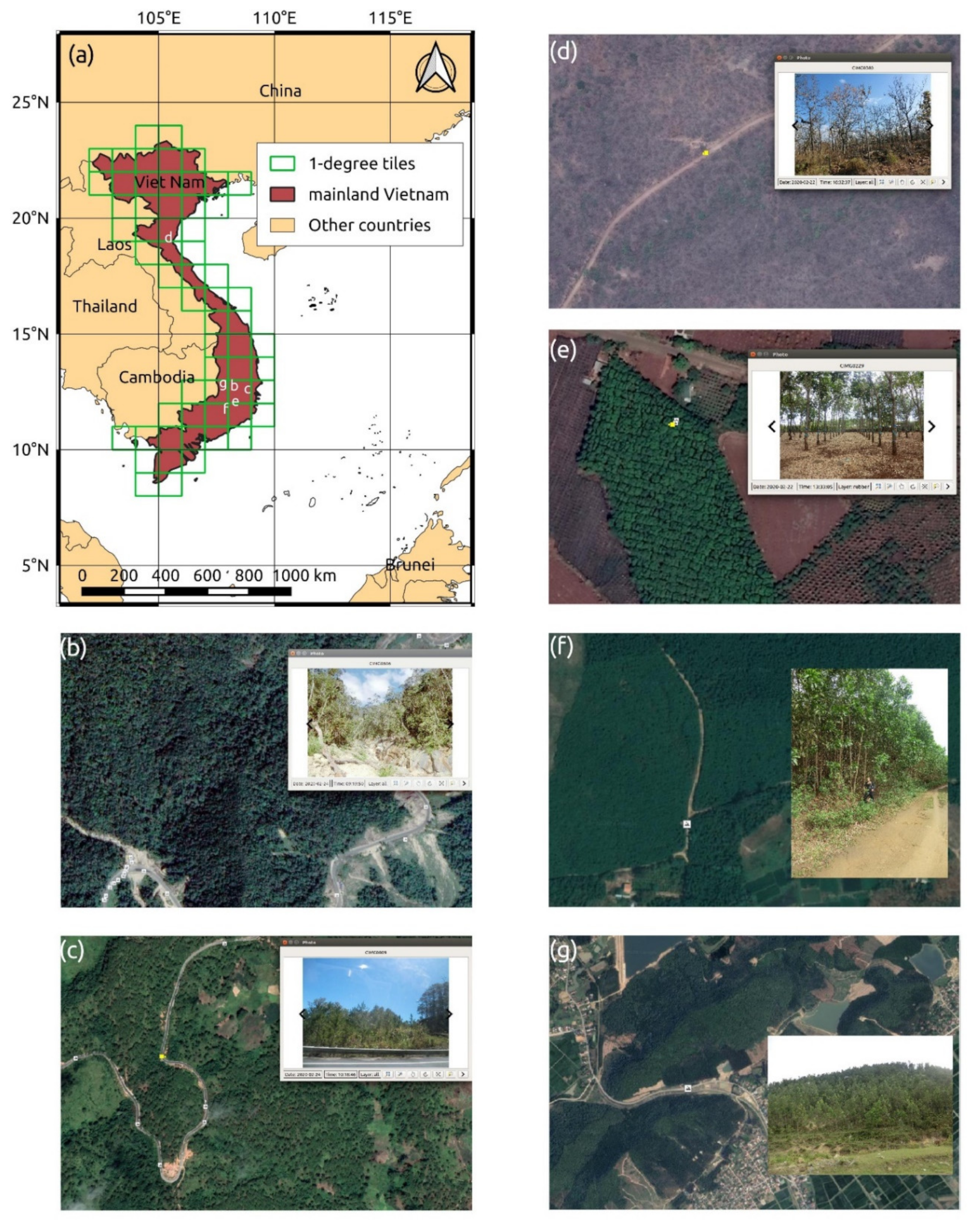
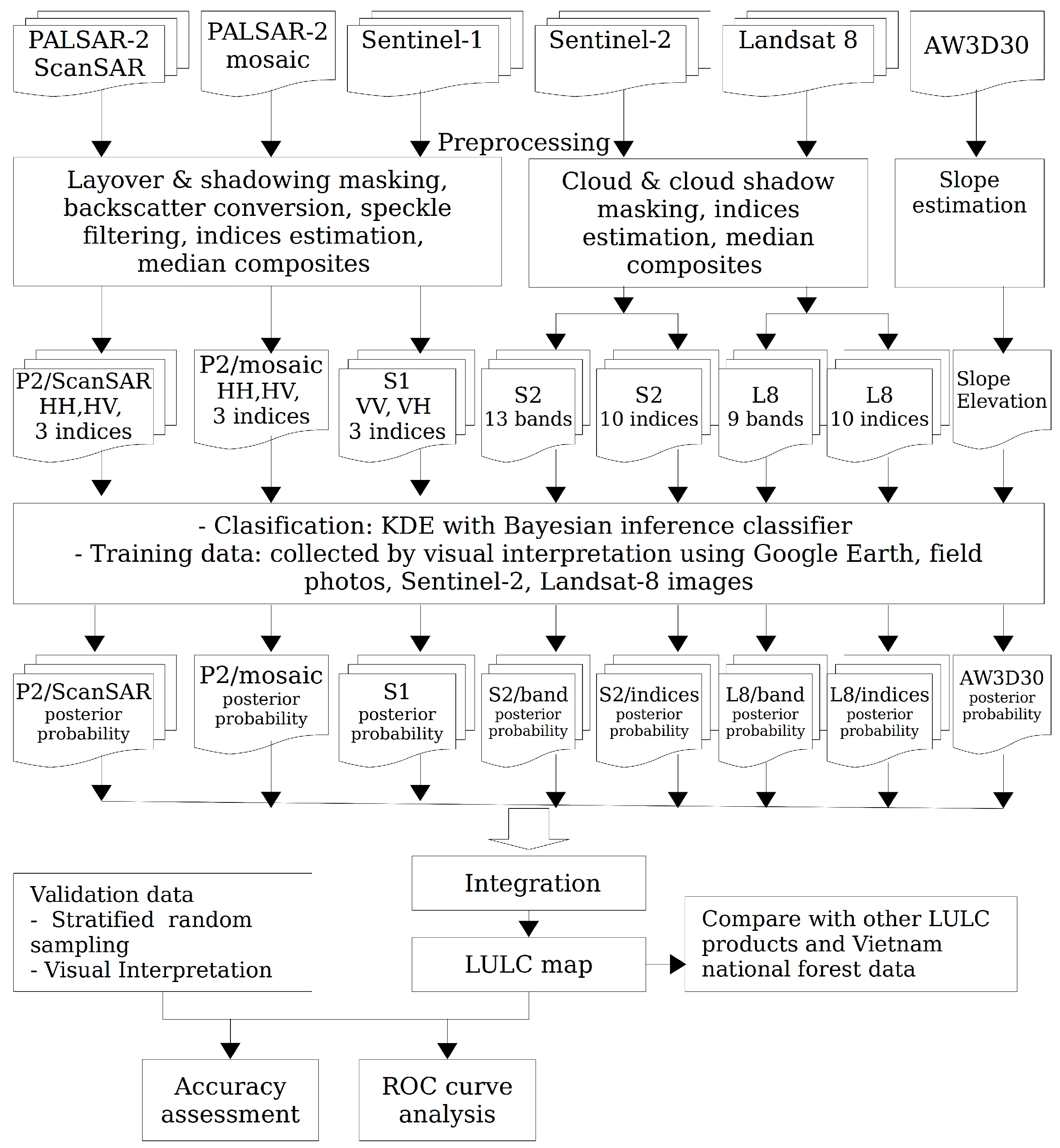
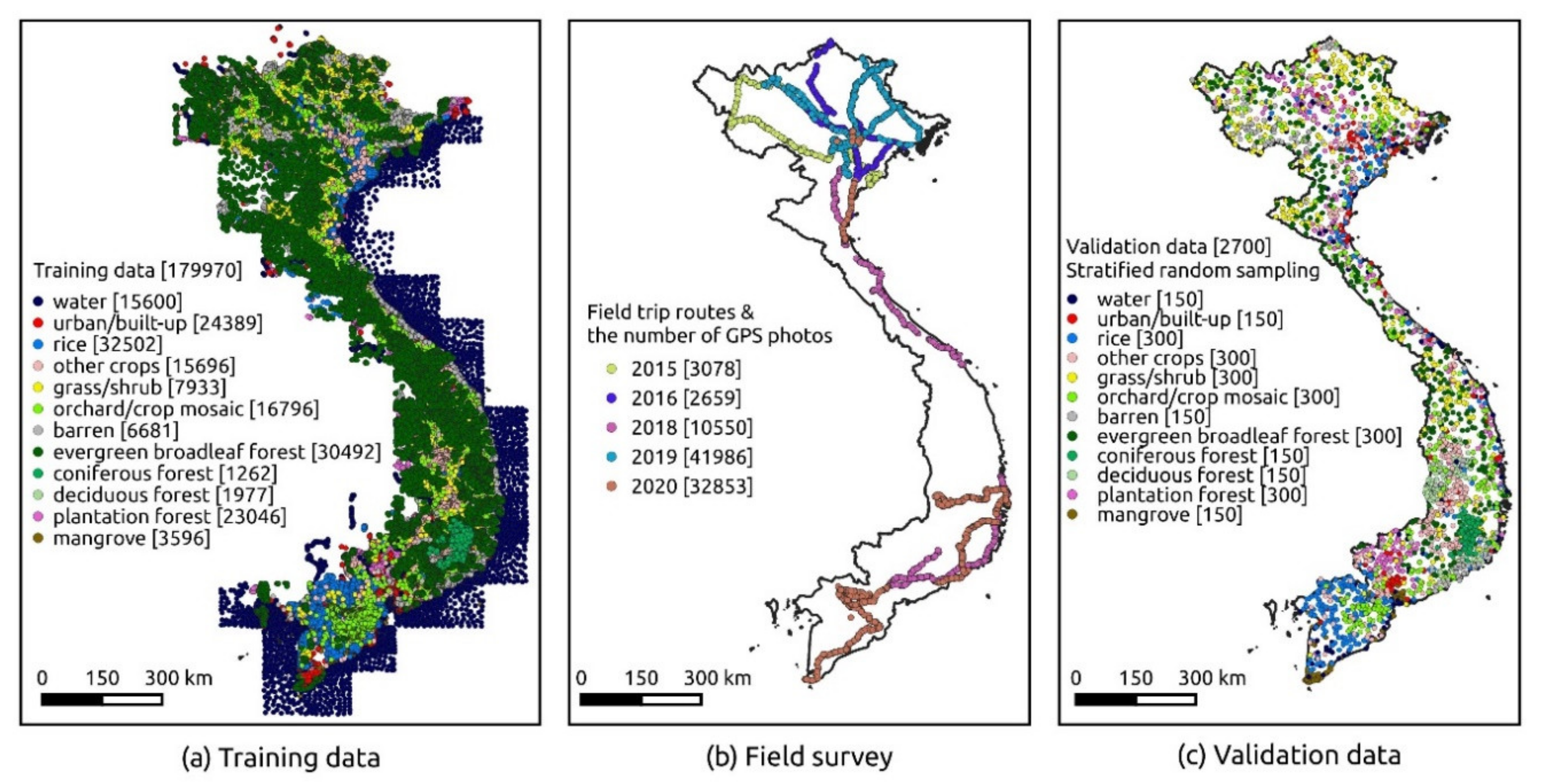
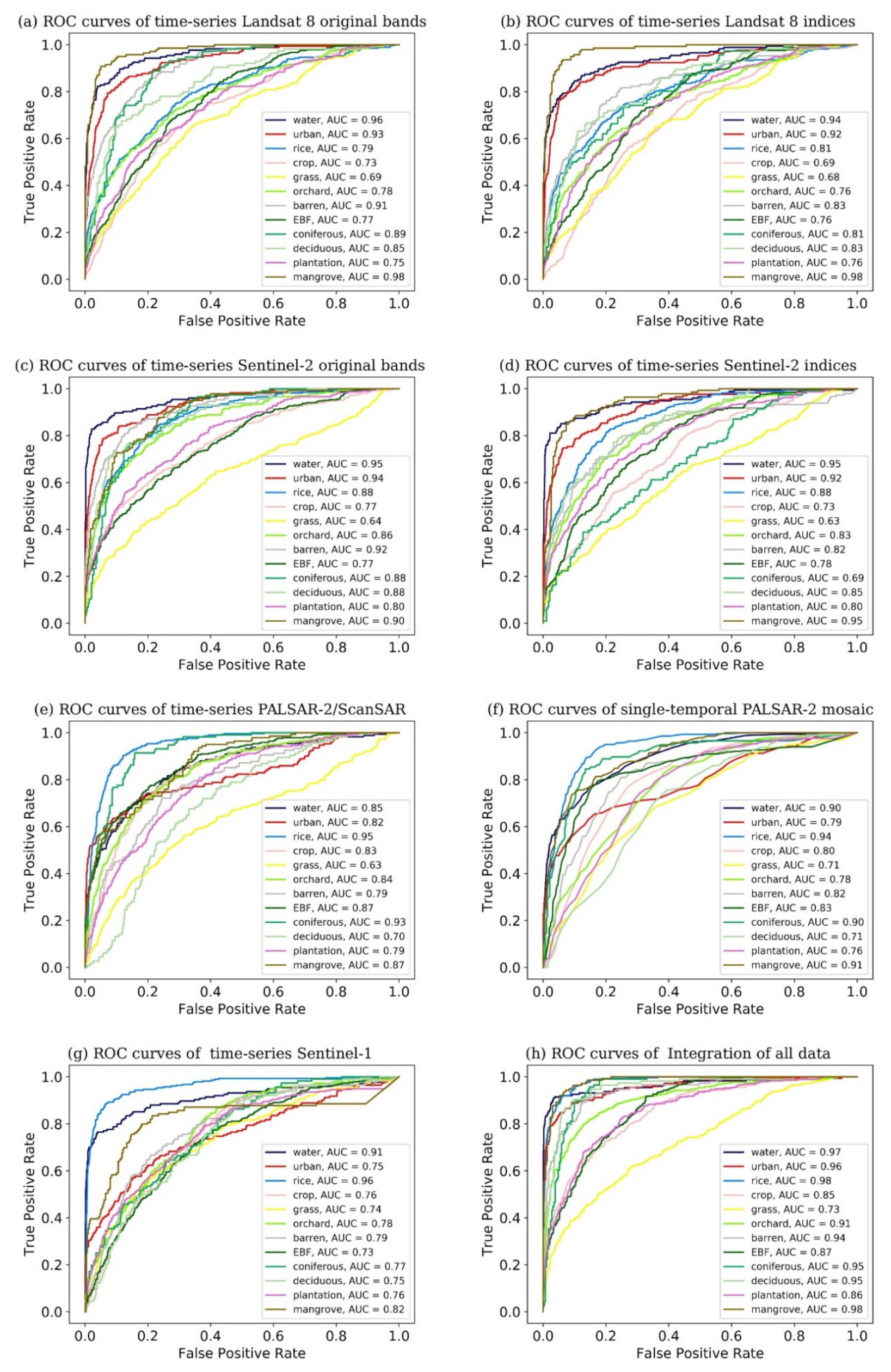
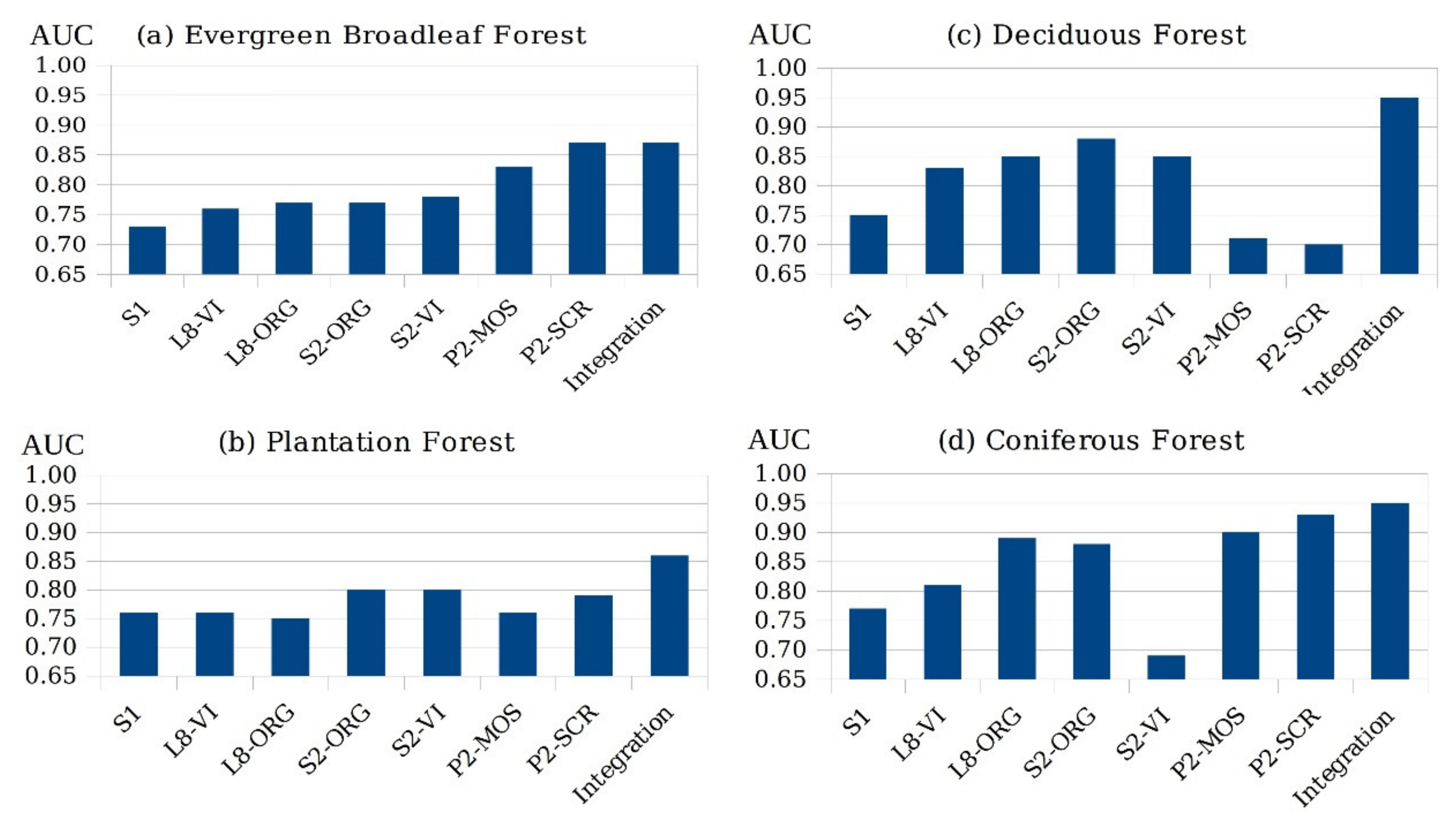
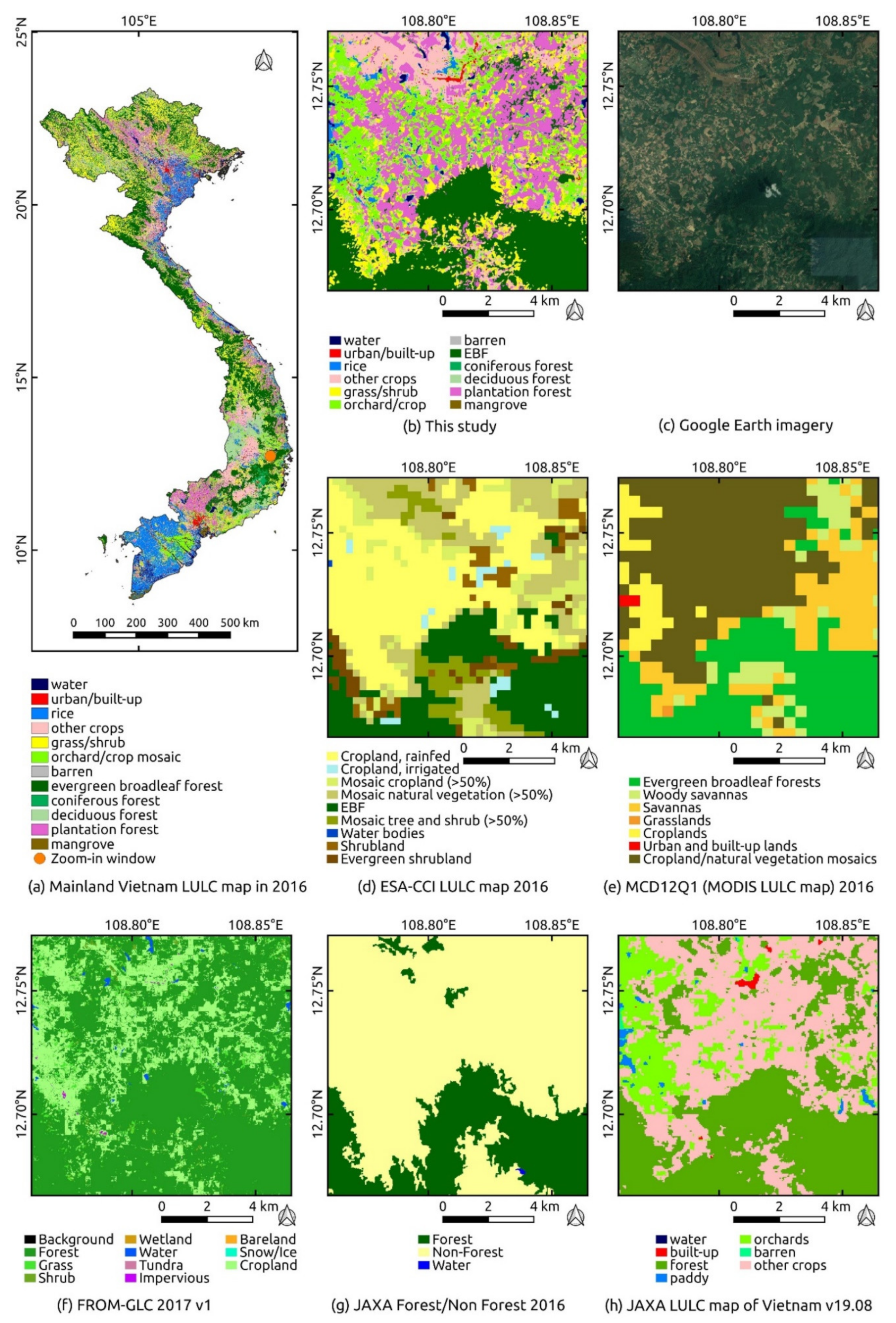
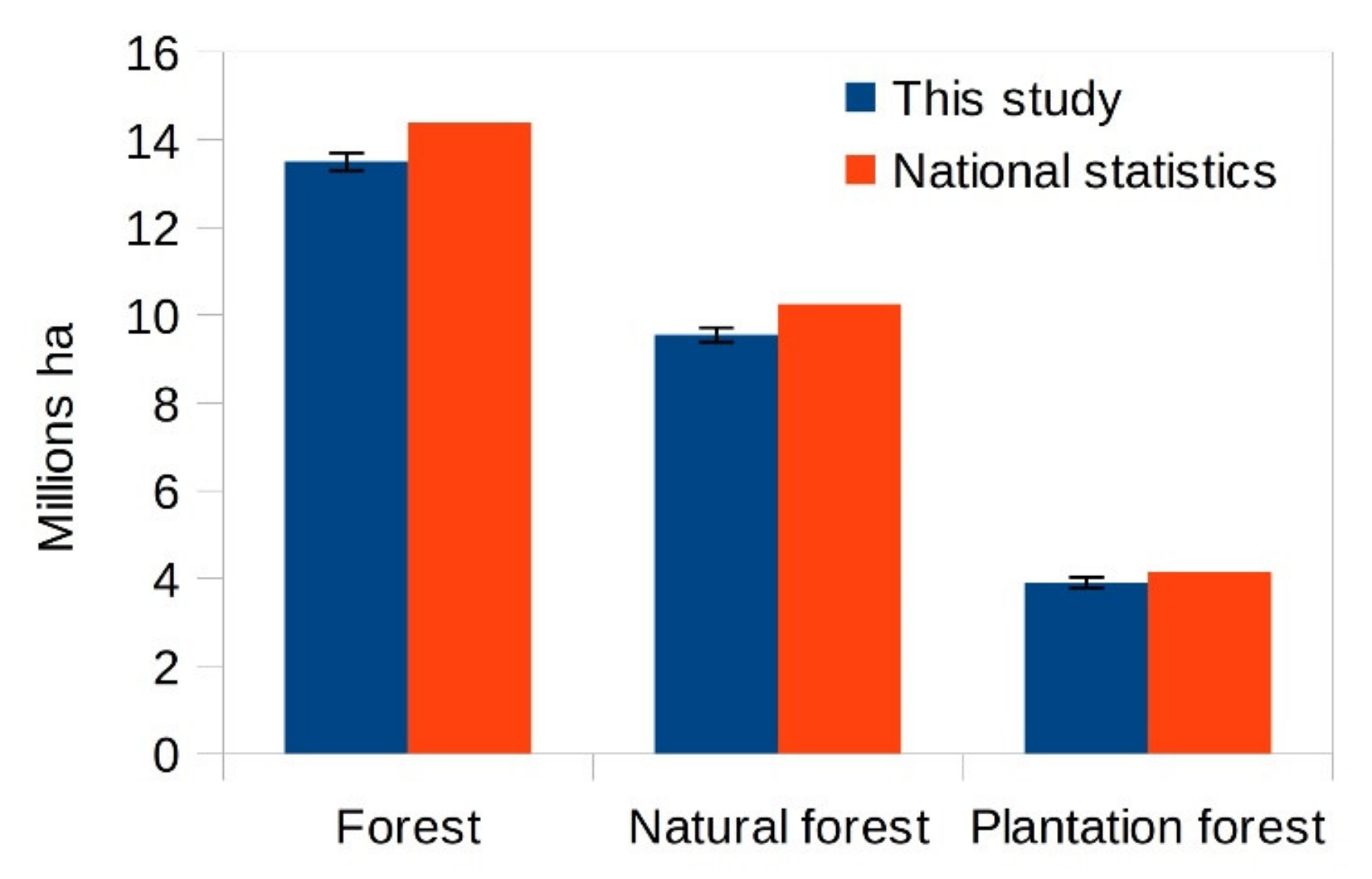
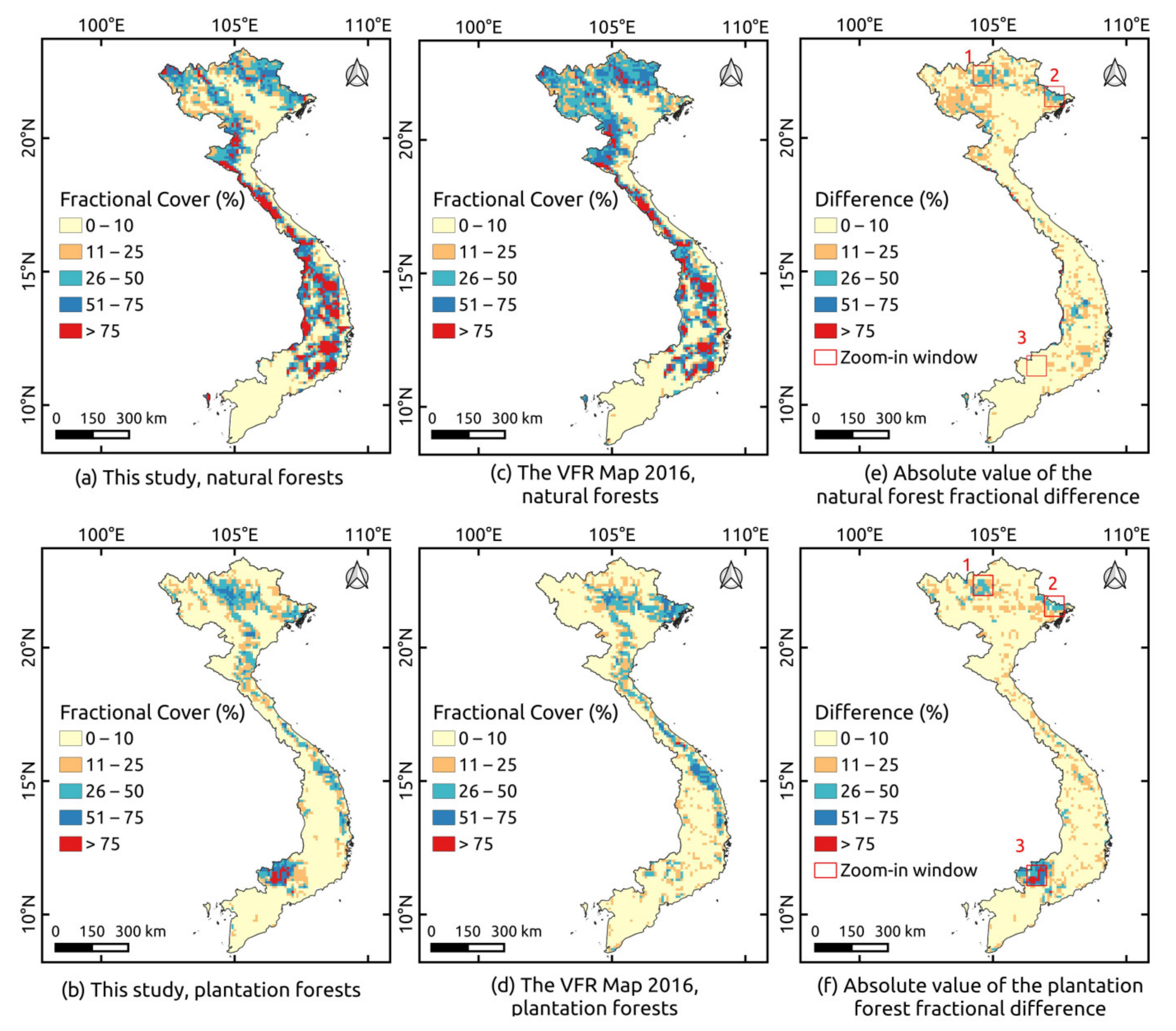
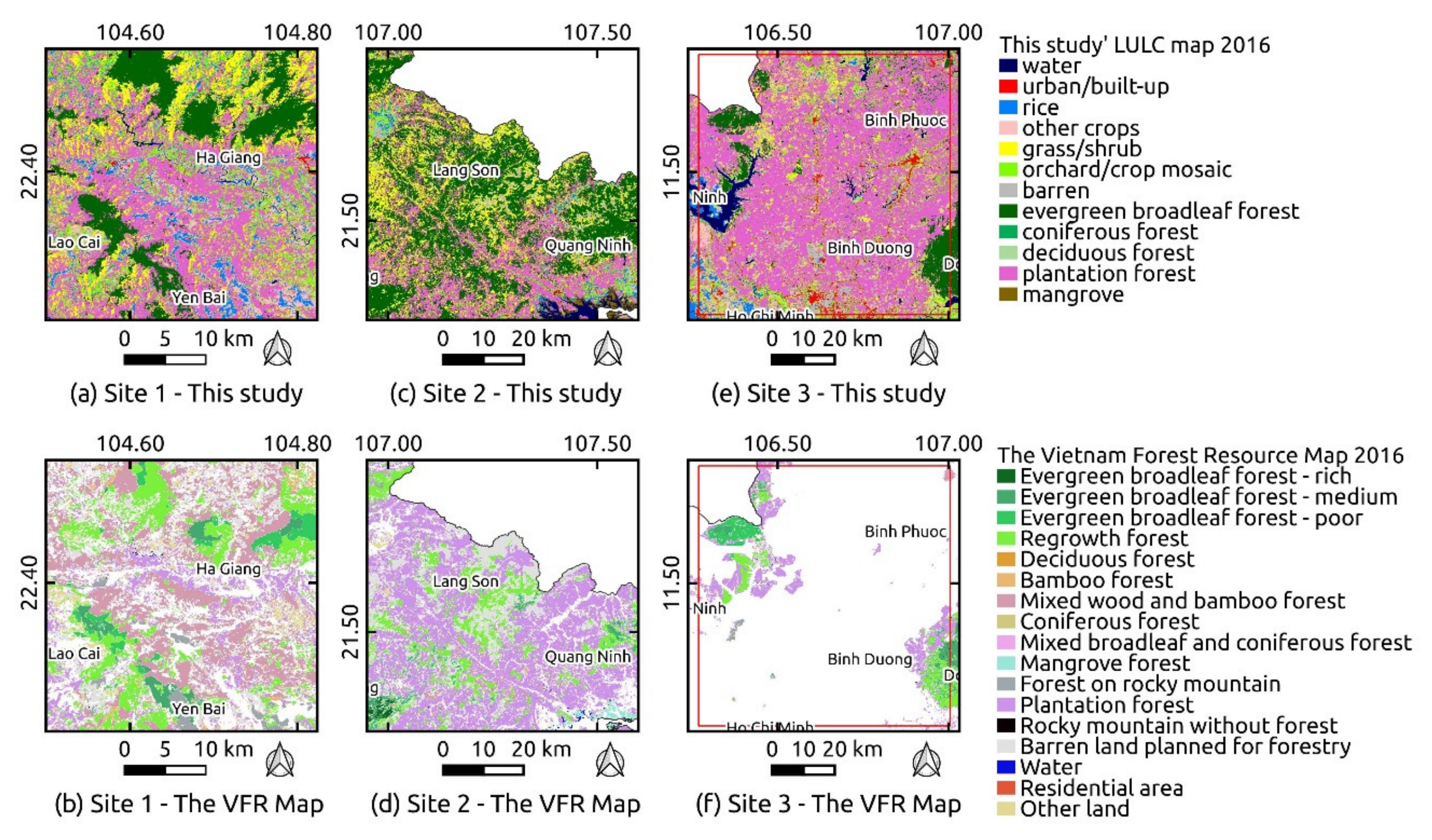
| Data | Band | Spectral Range (nm) | Electromagnetic Region |
|---|---|---|---|
| Sentinel-2A | Band 1 | 432–453 | Aerosols |
| Band 2 | 459–525 | Blue | |
| Band 3 | 542–578 | Green | |
| Band 4 | 649–680 | Red | |
| Band 5 | 697–712 | Red Edge 1 | |
| Band 6 | 733–748 | Red Edge 2 | |
| Band 7 | 773–793 | Red Edge 3 | |
| Band 8 | 780–886 | NIR (Near Infrared) | |
| Band 8A | 854–875 | Red Edge 4 | |
| Band 9 | 935–955 | Water vapor | |
| Band 10 | 1358–1389 | Cirrus | |
| Band 11 | 1568–1659 | SWIR1 (Shortwave Infrared 1) | |
| Band 12 | 2115–2290 | SWIR2 (Shortwave Infrared 2) | |
| Landsat 8 | Band 1 | 430–450 | Coastal aerosol |
| Band 2 | 450–510 | Blue | |
| Band 3 | 530–590 | Green | |
| Band 4 | 640–670 | Red | |
| Band 5 | 850–880 | NIR (Near Infrared) | |
| Band 6 | 1570–1650 | SWIR1 (Shortwave Infrared 1) | |
| Band 7 | 2110–2290 | SWIR2 (Shortwave Infrared 2) | |
| Band 10 | 10,600–11,190 | TIRS1 (Thermal Infrared 1) | |
| Band 11 | 11,500–12,510 | TIRS2 (Thermal Infrared 2) |
| Datasets | Year of Acquisition | Features of Each Images | Number of Images/Tile |
|---|---|---|---|
| PALSAR-2/ScanSAR | 2016 | HH, HV and 3 indices | 7 or 8 |
| PALSAR mosaic | 2016 | HH, HV and 3 indices | 1 |
| Sentinel-1 | 2016 | VV, VH and 3 indices | 8 |
| Sentinel-2 original bands | 2016 | 13 original bands | 8 |
| Sentinel-2 indices | 2016 | 10 indices | 8 |
| Landsat 8 original bands | 2016 | 9 original bands | 8 |
| Landsat 8 indices | 2016 | 10 indices | 8 |
| AW3D30 | - | Elevation and slope | 1 |
| Code | Category | Definition |
|---|---|---|
| 1 | Water | Permanent fresh/salt water bodies such as oceans, lakes, rivers, inundation areas |
| 2 | Urban/built-up | Artificial construction structures, impervious surfaces |
| 3 | Rice | Paddy fields with inundated planted rice |
| 4 | Other crops | Herbaceous crops or shrub crops other than rice |
| 5 | Grass/Shrub | Herbaceous or shrub (nonwoody) natural vegetation |
| 6 | Orchard/Crop mosaic | Tree crops and herbaceous crops mosaic, immature plantation trees |
| 7 | Barren | Lands with exposed soil, sand or rocks that always have vegetation cover less than 10% |
| 8 | Evergreen broadleaf forest | Mixed natural forests dominated by evergreen broadleaf trees |
| 9 | Coniferous forest | Natural forests with coniferous trees (mostly evergreen coniferous). |
| 10 | Deciduous forest | Natural forests with deciduous or semi-deciduous trees (mostly deciduous or semi-deciduous broadleaf). |
| 11 | Plantation forest | Mature acacia, rubber, eucalyptus and other plantation trees |
| 12 | Mangrove | Woody vegetation on waterlogged soil, mostly along the coastline |
© 2020 by the authors. Licensee MDPI, Basel, Switzerland. This article is an open access article distributed under the terms and conditions of the Creative Commons Attribution (CC BY) license (http://creativecommons.org/licenses/by/4.0/).
Share and Cite
Hoang, T.T.; Truong, V.T.; Hayashi, M.; Tadono, T.; Nasahara, K.N. New JAXA High-Resolution Land Use/Land Cover Map for Vietnam Aiming for Natural Forest and Plantation Forest Monitoring. Remote Sens. 2020, 12, 2707. https://doi.org/10.3390/rs12172707
Hoang TT, Truong VT, Hayashi M, Tadono T, Nasahara KN. New JAXA High-Resolution Land Use/Land Cover Map for Vietnam Aiming for Natural Forest and Plantation Forest Monitoring. Remote Sensing. 2020; 12(17):2707. https://doi.org/10.3390/rs12172707
Chicago/Turabian StyleHoang, Thanh Tung, Van Thinh Truong, Masato Hayashi, Takeo Tadono, and Kenlo Nishida Nasahara. 2020. "New JAXA High-Resolution Land Use/Land Cover Map for Vietnam Aiming for Natural Forest and Plantation Forest Monitoring" Remote Sensing 12, no. 17: 2707. https://doi.org/10.3390/rs12172707
APA StyleHoang, T. T., Truong, V. T., Hayashi, M., Tadono, T., & Nasahara, K. N. (2020). New JAXA High-Resolution Land Use/Land Cover Map for Vietnam Aiming for Natural Forest and Plantation Forest Monitoring. Remote Sensing, 12(17), 2707. https://doi.org/10.3390/rs12172707








